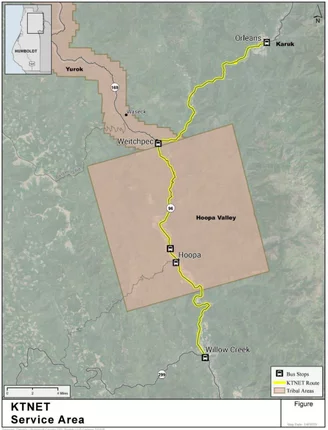
Map showing the existing and additional bus service and other project elements that will be funded with $17.5 million | Images from HTA grant proposal
As you likely know, the state of California is doing its dangdest to cut down on greenhouse gas emissions and a big part of the state’s climate plan includes reducing the number of gas-powered vehicles on the roads. To help make that happen, the California State Transportation Agency (CalSTA) has been providing funding to help improve public transportation access and convert transit vehicles to electric power across the state.
And the Humboldt Transit Authority (HTA) has received a lot of said grant money over the last year, including a recent $17.5 million Transportation and Intercity Rail Capital Program (TIRCP) grant, which will go toward deploying 10 battery electric vehicles, extending existing transit routes, building a new transit center in Crescent City and creating a new hydrogen fuel cell electric coach that can be used for long-distance transportation.
The grant application was a partnership between HTA, Redwood Coast Transit and the Yurok Tribe, which have all been working together to try to improve transportation connections between Humboldt and Del Norte Counties and tribal lands. The project will add four battery electric buses to the Yurok Tribal Transit Service, including the Tribe’s dial-a-ride service available to tribal members in the Klamath area. The electric vehicles will also be used to revive the Klamath Trinity Non-Emergency Transit service, which offers a bus route between Orleans and Willow Creek.
Natalie Arroyo, county supervisor and chair of the HTA board, told the Outpost that working on these forms of microtransit – small-scale public transit that falls somewhere between rideshare service and traditional bus service – is a good way to address the needs of our most rural areas, where public transportation is really needed to help residents reach jobs, grocery stores or medical services, but there aren’t enough daily riders to support regular bus routes.
“Working with the Yurok Tribe has been a fantastic opportunity,” Arroyo said in a recent phone interview. “I think we’ll have more opportunities to look at how microtransit works for communities throughout the North Coast. Because in many ways, traditional forms of transit don’t serve spread out, rural communities quite as well.”
In addition to those four buses, the funding will also be used to add six electric cutaway buses to the existing Redwood Coast Transit (RCT) route between Arcata and Crescent City and the route will be extended south to Eureka. Currently, to get between Crescent City and Eureka, riders have to transfer to a different bus line in Arcata. Eventually, the route will connect to the Eureka Regional Transit & Housing (EaRTH) Center, a mass transit hub planned to be built on Third Street between G and H streets in Eureka. Construction of the center, which will also be partly funded by CalSTA grants, is still in the planning stages and is expected to be completed by 2026.
The recent $17.5 million grant will also go toward the construction of a Del Norte County transit center in Crescent City, which is proposed for a publicly owned, 1.75-acre lot located at K and Front Streets. According to the agencies’ grant proposal, the site is ideal for several reasons, including that it is very near the Crescent City Library, the Redwood National and State Parks Information Center and the Cultural Center and the coastal trail. In addition to providing a center for the RCT vehicles, the transit center could also serve as a place for Redwood State and National Parks to provide shuttle service to and from locations within the parks.
Lastly, the funding will go toward supporting HTA’s efforts to work with a bus manufacturer to design and pilot a prototype over-the-road hydrogen fuel cell electric coach that is capable of traveling long distances.
Greg Pratt, HTA general manager, told the Outpost that HTA is currently working with bus company New Flyer, which created the hydrogen fuel cell electric buses HTA has been adding to its fleet over the past few years. Pratt said that New Flyer is working to increase their vehicle’s hydrogen storage capacity, to achieve a minimum range of 400 miles. The hope is for these coaches (buses with a raised passenger area with luggage storage underneath) to be used to operate a route between Eureka and Ukiah.
Proposed Crescent City transit center
As far as how long it will take for the prototype to be built and be available for use on the road, Pratt said it will probably take a couple of years. Adding the electric battery buses to the existing routes will probably take about nine months because of the way the bidding process works. But in the meantime, diesel buses will be added to provide the extended service – between Orleans and Willow Creek, and between Crescent City and Eureka – temporarily. The route extension between Eureka and Crescent City will probably be added within a couple of months, Pratt said.
“Eureka and Crescent City are two of the bigger cities in our area and a lot of people want to travel in between,” Pratt said. “The need is there now.”
All of the changes are a part of the efforts to increase connectivity between bus and train routes throughout Northern California and the entire state and to eventually transition to entirely zero-emission transit vehicles to meet the state’s goal to cut greenhouse gas emissions by 85 percent by 2045. And though there’s still a long way to go, Pratt and Arroyo said that these steps to help reduce people’s reliance on cars and other gas-powered vehicles are helping us get there.
“Surface transportation is one of the biggest impacts to our climate, making up more than 50 percent of emissions in most communities,” Arroyo said. “If people can use transit more easily, even occasionally, that can make a difference.”


CLICK TO MANAGE